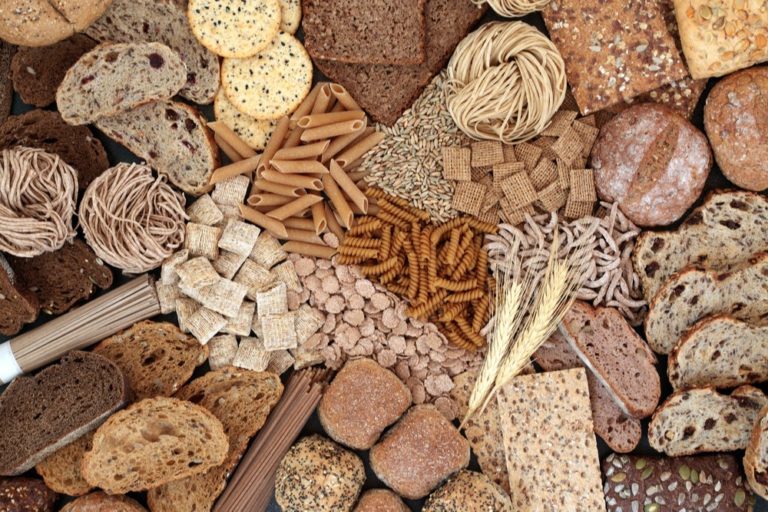Would you believe that on average, we don’t eat enough fibre? The recommended intake is 30g per day for men, and 25g per day for women, but the average intake is 17.2g for women and 20.1g for men.
Low fibre intake is generally associated with constipation and some gut diseases, but it can also influence our mood (and not in a good way). What’s particularly interesting is that high fibre diets have been seen to reduce cholesterol, diabetes risk and help protect against certain cancers and of course it can support our gut function, along with our mood.
If we should be increasing our fibre intake, it makes sense to learn a little more about it first. If we know why we should do something, it often makes it easier to achieve.
What Is Fibre?
Fibre is technically a carbohydrate which is where the problem often lies. When we opt for low carb diets, we inadvertently reduce our fibre intake too!
Carbohydrates are made up of three components:
Fibre,
Starch,
Sugar.
Sugar is a simple carb, having fewer molecules to digest and break down, it sends an immediate burst of glucose into the bloodstream.
Fibre and starch however are complex carbs, having longer chains of molecules. Starch takes longer to digest, having a more gradual effect on the body, and well fibre, is a non-digestible complex carbohydrate. Although it’s not digestible, it can be fermented in the gut, and this is where we reap many of its rewards.
Fibre for Gut Health
When fibre is fermented in the gut, it produces compounds known as short-chain fatty acids or SCFAs. These guys can provide fuel for intestinal cells, strengthen the gut barrier, and keep those tight junctions nice and, well, tight. SCFAs also stimulate mucous production, which actually forms another barrier in the gut – this plays an important role in protecting against harmful pathogens.
In cases of low fibre diets, the bacteria which reside in the gut start to eat this mucosal barrier because they haven’t got any fibre to feed on. This then leads to a poor mucosal integrity, which is implicated in many gut issues.
Fibre for Mental Health
SCFA’s can also affect our mood! They affect levels of neurotransmitters (which are the chemical messengers in the body’s nervous system) that can alter how we feel and behave. Higher levels of butyrate (one of the SCFA’s) have been seen to improve mood and reduce anxiety scores.
But it’s not only SCFA’s that can influence our mood. Certain bacteria produce certain neurotransmitters too. For example, lactobacillus bacteria produce the neurotransmitter GABA which is seen as the main inhibitory neurotransmitter. This contributes to feelings of calm.
Fibre for Cardiovascular Health
Cardiovascular disease is an inflammatory disease and diet is often considered the cornerstone for treatment. Many studies have demonstrated that high amounts of dietary fibre can significantly reduce the risk of cardiovascular disease. It is thought that fibre reduces cholesterol and fatty acid absorption and reduces glucose absorption along with decreasing insulin secretion.
Fibre for Bowel Health
Less-fermentable fibre can act as bulking agents and help prevent constipation, but with any increase in fibre, fluid intake should increase too! Dietary fibre is one of the main factors discussed in protecting against colorectal cancer too.
So, if we know that we should be eating more fibre, how do we do it?
Aim for 30g of fibre per day, but realistically, any addition to your diet is a great place to start. Think about adding an extra portion of veggies to your meal, pop some lentils in with your mince dishes, or grate some carrot in your meatballs!
The easiest way to optimise your dietary choices is to consider which beneficial foods you can add to your day. You will naturally find you reduce your less beneficial food choices.
Sources of Fibre:
40g oats – 3.1g fibre count
1 slice rye bread – 3.6g fibre count
½ cup quinoa – 5.6 fibre count
70g broccoli – 2.8g fibre count
160g new potatoes – 2.9g fibre count
80g beans – 3.3g fibre count
64g raspberries – 4.3g fibre count
1 medium pear – 4.3g fibre count
28g almonds – 4.5g fibre count
96g red lentils – 4.7g fibre count
½ tin green lentils – 9.2g fibre count
1 cup cannellini beans – 7.2g fibre count


